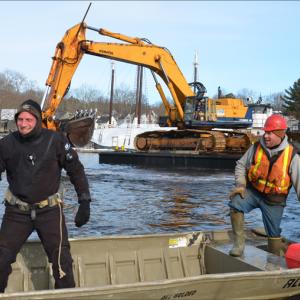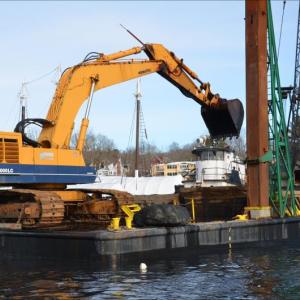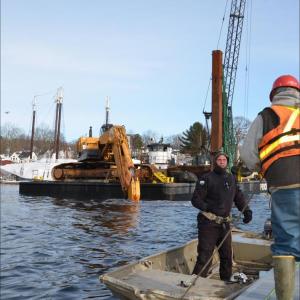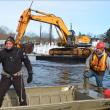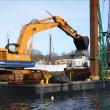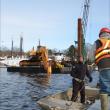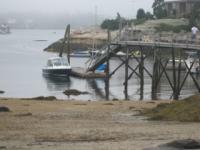Prock Marine begins dredging Camden Harbor
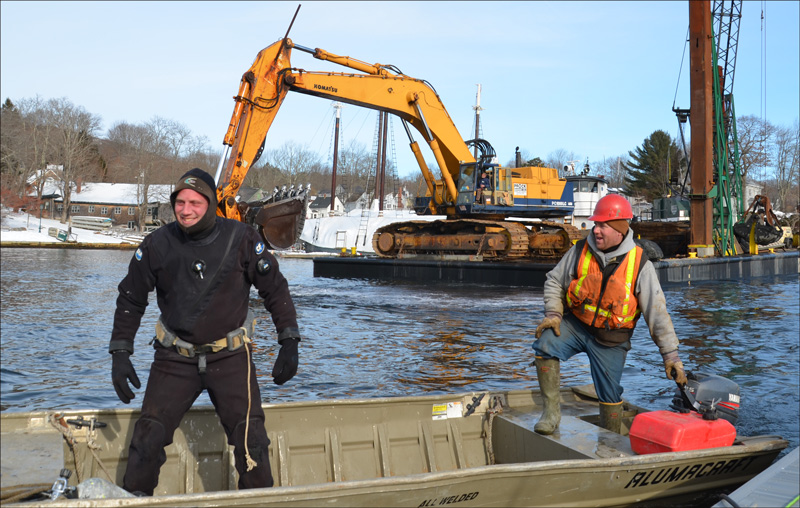 Toby Wincklhofer prepares to dive into Camden Harbor Jan. 11 to release line that had tangled with a tug's propeller. Jamie Dever takes him over to the spot in his skiff. (Photo by Lynda Clancy)
Toby Wincklhofer prepares to dive into Camden Harbor Jan. 11 to release line that had tangled with a tug's propeller. Jamie Dever takes him over to the spot in his skiff. (Photo by Lynda Clancy)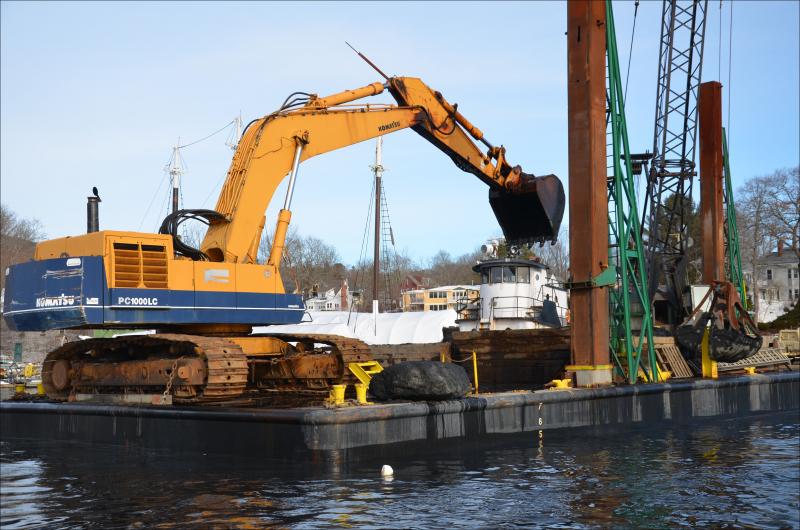 The dredging begins with a crane and clamshell bucket. (Photo by Lynda Clancy)
The dredging begins with a crane and clamshell bucket. (Photo by Lynda Clancy)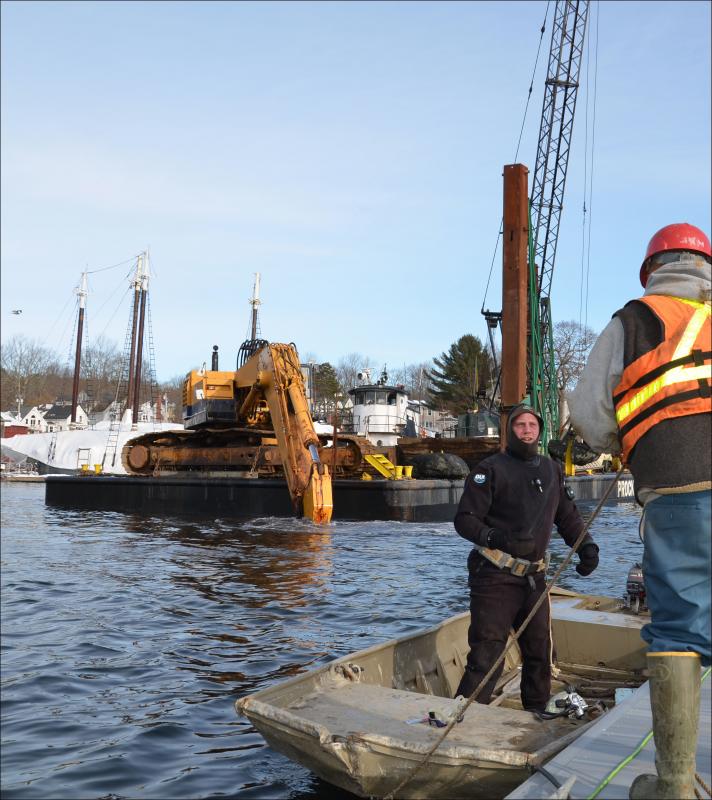 Toby Wincklhofer will dive beneath the tug to detangle line from a propeller with Jamie Dever taking him over to tug. (Photo by Lynda Clancy)
Toby Wincklhofer will dive beneath the tug to detangle line from a propeller with Jamie Dever taking him over to tug. (Photo by Lynda Clancy)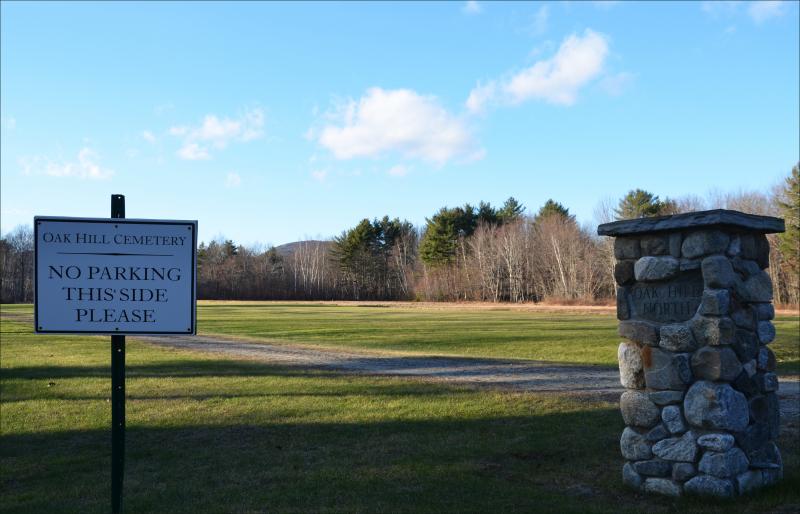
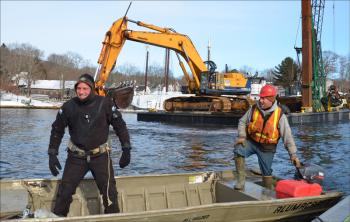 Toby Wincklhofer prepares to dive into Camden Harbor Jan. 11 to release line that had tangled with a tug's propeller. Jamie Dever takes him over to the spot in his skiff. (Photo by Lynda Clancy)
Toby Wincklhofer prepares to dive into Camden Harbor Jan. 11 to release line that had tangled with a tug's propeller. Jamie Dever takes him over to the spot in his skiff. (Photo by Lynda Clancy)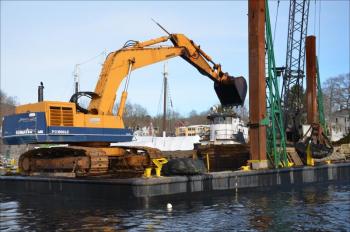 The dredging begins with a crane and clamshell bucket. (Photo by Lynda Clancy)
The dredging begins with a crane and clamshell bucket. (Photo by Lynda Clancy)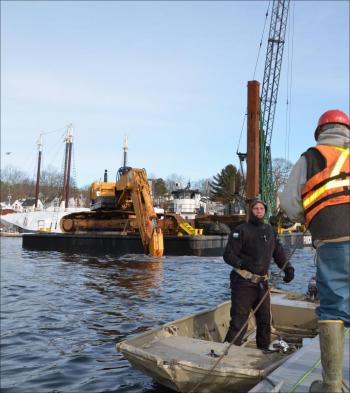 Toby Wincklhofer will dive beneath the tug to detangle line from a propeller with Jamie Dever taking him over to tug. (Photo by Lynda Clancy)
Toby Wincklhofer will dive beneath the tug to detangle line from a propeller with Jamie Dever taking him over to tug. (Photo by Lynda Clancy)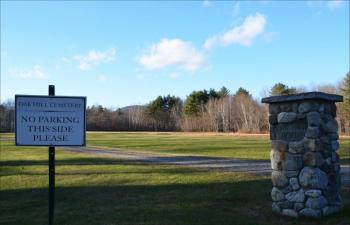
CAMDEN — Dredging has begun in Camden's inner harbor, with an expected 2,000 cubic yards of gravel, silt and rocks to be lifted from the bottom and transported to Oak Hill Cemetery on Hosmer Pond Road to help level the town's burial ground.
Prock Marine, based in Rockland, set up operations in the harbor this week, lifting black sludge with a clamshell bucket and dumping it onto a barge. A tugboat was helping to move the barge into place.
The bulk of the dredging is occuring at the head of the harbor where the Megunticook River empties into Camden Harbor. That area is above the town landing, near the the waterfall, and below the Montgomery Dam. The two additional areas include near the town's Bay View Street stormwater outlet pipe and at the Camden Yacht Club. The total coastal wetlands area affected will be 21,600 square feet (12,000 at the harbor head, 1,600 at the stormwater outlet, and 8,000 feet at the yacht club).
Dredging the harbor occurs every 10 years, or so. The last time was in 2002 and 2003, when the U.S. Army Corps of Engineers cleared the federal channel, including alongside the northeastern edge of the harbor. At that time, the Corps removed an estimated 4,500 cubic yards of silt and clay with a clamshell bucket on a barge-mounted crane, loaded it onto a scow and towed it to a designated disposal site off of Rockland in West Penobscot Bay. The Corps dredged within the harbor to a depth of 10 feet at mean low water.
At the same time, Camden dredged approximately 30 years of silt that accumulated at the head of the harbor behind the Montgomery Dam.
This year, the project is considered a maintenance dredge by Camden Harbor Master Stephen Pixley, and necessary to ensure "proper clearance for the many commercial and recreational vessels that navigate and dock their boats in Camden," as he wrote in an August memo to the state Department of Environmental Protection.
Prock Marine has been hired for the job at $30,000 per week and Camden has set aside funds in a Harbor Dredge Reserve Fund to cover the project, according to Pixley. The town is estimating the project will take two to three weeks. On Sept. 18, the board unanimously approved a contract with Prock Marine for an amount not to exceed $90,000.
According to the application approved by the state Department of Environmental Protection Nov. 29, the dredging again entails using a clamshell bucket and crane. The fill will be used at Oak Hill Cemetery North to create additional burial ground and will be contained there by a silt fence and hay bales, if necessary. In 1992, the town also used dredge material to fill the cemetery, according to the DEP.
The DEP's Natural Resources Protection Act Coastal Wetland Alteration permit was issued with the condition that Camden will ensure that the project will not result in measurable soil erosion at the dredging sites. The Maine Department of Inland Fisheries and Wildlife reviewed the project, finding no Essential or Significant Wildlife Habitat will be affected. The Department of Marine Resources said the dredging should occur between November and April 15 to minimize effects on migrating fish and fishing activity at the outlet of the Megunticook River, the lobster fishery in the bay and boating activity.
The DEP said the amount of coastal wetlands to be altered must be kept to "the minimum amount necessary for meeting the overall purpose of the project." Camden has reduced the impact to the wetlands by confining the dredging footprint to the same areas that were dredged in 2002 and 2003, the DEP said, in its permit summary.
The DEP waived the Camden's requirement to test for dioxin after the town included in its application the 2002 and 2003 laboratory analysis results. Camden said there are currently no known industrial businesses on the harbor, nor does the town have any industry that uses or burns products containing chlorine. Camden's last textile mill closed in the late 1980s and the Apollo Tannery, which was sited along the river, closed in the late 1990s.
"....The water flowing from the Megunticook River into the Camden Harbor has not had any industrial usage with direct linkage to any industry for at least 40 years," wrote Pixley in his memo to DEP.
The dredging area at the head of the harbor at the base of the falls is a likely spot where material from the Megunticook River is deposited, according to a memo from Camden's superintendent of the Wastewater Department, Ross Parker. He agreed with Pixley, saying the possible presence of dioxin in that material would probably be low because there has been no industrial wastewater deposited into the river since 1970, when the wastewater treatment plant began operation.
"Since the area to be dredged is also adjacent to the outlet for the Wastewater Treatment Plant, it might seem possible that if there were dioxin in our effluent that the dredged material could be contaminated from that source," Parker wrote.
But, he added, he spoke to New England Organics, the company that composts sludge from Camden's treatment plant, and staff there indicated that testing does not indicate dioxin in Camden's processing of waste.
Editorial Director Lynda Clancy can be reached at lyndaclancy@PenBayPilot.com; 706-6657.
Event Date
Address
United States

